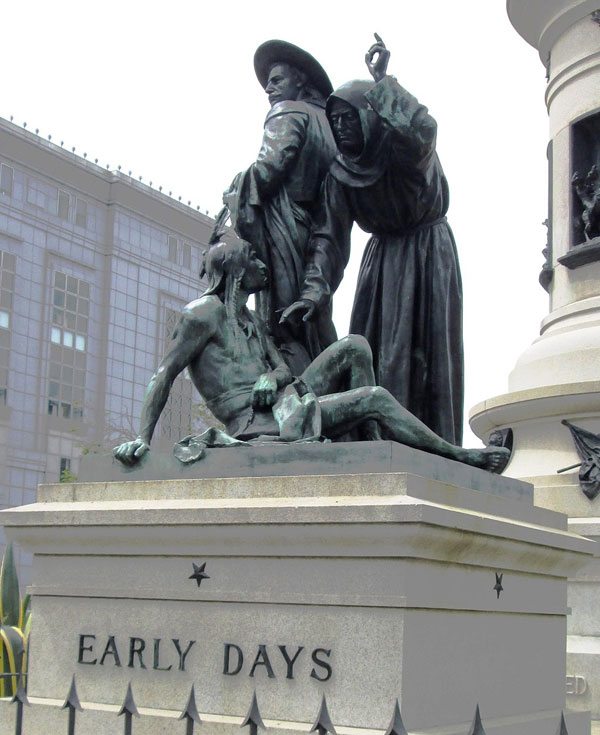
March 5, 2018; San Francisco Examiner
“San Francisco will take down the controversial ‘Early Days’ statue depicting Native Americans in a demeaning manner after the Arts Commission voted unanimously to have it removed Monday,” reports Joshua Sabatini in the San Francisco Examiner. The commission, in a memo supporting its action, noted that it did so due to “the allegorical sculpture’s depiction of the degradation and genocide of [American Indian] peoples, utilizing visual stereotypes common at the turn of the twentieth century to depict all [American Indians] which are now universally viewed as disrespectful, misleading, and racist.”
The statue, notes Sabatini, “is part of the larger bronze and granite Pioneer Monument located between the Main Public Library and the Asian Arts Museum.” It depicts an American Indian on the ground, cowering before a mission priest and a cowboy, both of whom tower over him.
The statue’s removal was supported, Sabatini writes, “by the late Mayor Ed Lee, as well as by Mayor Mark Farrell and Supervisor Jane Kim, who represents the Civic Center area where it is on display.”
The statue will be placed into storage. “It’s possible, Sabatini adds, “that it could one day find a home in a museum.”
Tom DeCaigny, who directs cultural affairs for the Arts Commission, says the vote is “a very significant and historical moment” for the city and the country.
“There have been lots of conversations about appropriate representation of monuments in the public realm,” says DeCaigny. “I have heard feedback that in some way we are looking to revise history or forget history. I would argue quite the opposite. This is us recognizing history and the evolution of history and doing the right thing on the right side of history.”
Sign up for our free newsletters
Subscribe to NPQ's newsletters to have our top stories delivered directly to your inbox.
By signing up, you agree to our privacy policy and terms of use, and to receive messages from NPQ and our partners.
Art Commission Chair J.D. Beltran adds,
One of the justified objections to it being on public land, in a public place, is that by it continuing to be there it signals any city’s or municipality’s implicit endorsement of the racism within the statue. Whereas when it is in a place where it is recognized as being historical and being able to be surrounded by other historical artifacts and put into context then that endorsement disappears.
The Arts Commission first voted in October 2017 to initiate the process for the statue’s removal. The Historic Preservation Commission voted February 21st to allow the statue’s removal, conditional on a plaque being placed at the site explaining why it was removed. A staff analysis found that removal of the statue would “not affect the integrity of the Civic Center Landmark District as a whole.”
The Arts Commission estimates the cost for removal of the statue could range between $160,000 and $200,000, which includes $60,000 for 10 years of offsite storage. Arts Commission staff said removal should occur within months.
The statue’s origins can be traced to a $100,000 gift made to the city by real estate investor James Lick upon his death in 1876. American sculptor Frank H. Happersberger completed the sculpture in 1894.
“In the early 1990s,” Sabatini notes, “there were unsuccessful calls for removing the statue when the monument was relocated from Hyde and Grove streets to its current site on Fulton Street between Larkin and Hyde streets to make way for construction of the Main Public Library.” According to Sabatini, the renewed calls to remove the statute were prompted in large measure by San Franciscans’ disgust with the white supremacist violence in Charlottesville last August.—Steve Dubb













